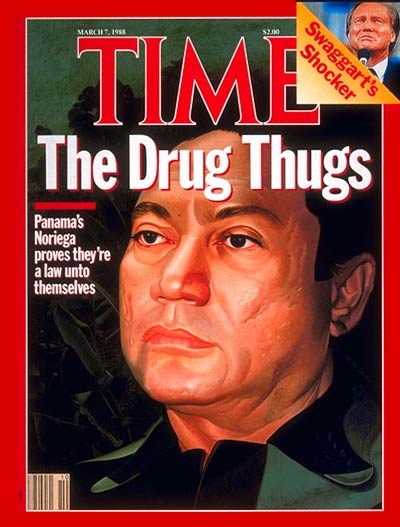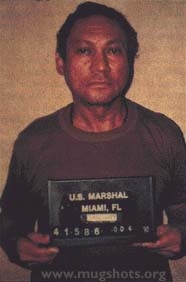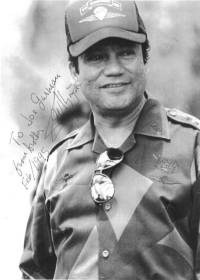|

Manuel
Antonio Noriega- Manuel
Antonio Noriega was born to an
accountant and his maid in a poor section of Panama City, Panama, in
1934. When he was five he was given up for
adoption
to a schoolteacher. He attended the National Institute High
School,
with aspirations of becoming a doctor.
Noriega's family could not afford medical school so he
accepted a
scholarship to attend the Chorizos
Military Academy
in Peru. In 1962 he graduated with a degree in
engineering. Noriega received
intelligence and counterintelligence training at the School of the Americas at Fort Gulick in 1967, and
also took a
course in psychological operations (Psyops) at Fort Bragg, North Carolina.
Career- In 1967 Noriega was
commissioned in the
Panama
National Guard and promoted to lieutenant in 1968.
Noriega worked with the Central Intelligence
Agency (CIA) from the late 1950’s to the 1980’s. He
was on the CIA payroll for most of this
time, although the relationship did not become contractual until 1967.

Noriega
retained U.S.
support until February 4,
1989, when the Drug Enforcement Administration (DEA) indicted him on
federal
drug charges. The U.S. saw Noriega as a double agent and
the state
Department nicknamed him “rent-a-colonel” and believed that he gave
information
not only to the U.S.
and U.S. allies, Taiwan
and Israel, but
also to
communist Cuba. He also sold weapons to the leftist
Sandinista government in Nicaragua
in the late 1970’s.
Noriega
in the 1980’s promoted himself to a full
general. He was a close ally of the United States and pledged to help the
Reagan
administration in their efforts to destabilize the Sandinista
government in Nicaragua.
After
the Iran-Contra Affair, Noriega became a
liability to the United
States.
In 1988, the DEA indicted Noriega on charges of drug
trafficking. The next year, Noriega voided
national
elections. President George H. W.
Bush stepped
in and authorized a military invasion of the Caribbean
nation with the sole purpose of deposing the dictator.
A standoff occurred and Noriega surrendered
to U. S.
forces on January 3, 1990.
Events
Leading Up To Noriega’s Capture- On December
20, 1988 around 12:45 am, the U.S.
armed forces began one of the costliest and deadliest arrest missions
in recent
history. Twenty-five thousand American
troops
invaded Panama
with orders to capture General Manuel Antonio Noriega.
He surrendered after two weeks of holing up
in the Papal Embassy.

Manuel
Noriega’s Trial- Noriega’s
trial was held from September 6, 1991- April 9, 1992.
He was charged with: drug trafficking, racketeering,
and conspiracy. Judge William M.
Hoeveler presided over the trial which was held in Miami, Florida. The verdict came back as guilty and Noriega
was sentenced to 40 years in prison. His
sentence was later reduced to 30 years, and further reduced to 17 years.
One
of the chief prosecutor’s of the trial, Michael
Sullivan derided Noriega as a “small man in a general’s uniform,” who
gave his
“permission, authorization, and encouragement to a scheme to transform
his
nation into an international cocaine trafficking and manufacturing
center.”
In
a surprise move the defense counsel Frank Rubino
waived his right to deliver an opening statement to the jury. His reasoning behind this move was to wait
until the prosecution had revealed its entire hand before deciding the
direction that the defense would take.
Significance
of Trial:
This
was a landmark trial which marked the first time
that a former head of a foreign government had ever faced criminal
charges in
an American court of law.

Picture
of Noriega after finding Christ in prison
Manuel
Noriega Now- On Wednesday, April 8, 2009, a
federal appeals
court ruled that Noriega could be taken to France
to face money laundering
charges. This ruling rejected the former
Panamanian dictator’s bid to return to his native country of Panama. Noriega’s attorney Jonathan May of Miami said an
appeal was
likely. At
the end of all legal proceeding the courts
will make a recommendation to U.S. Secretary of State, Hillary Clinton
to decide
if Noriega will be released back to his country of Panama
or be extradited to France
to face charges of money laundering.
Additional
Links-
http://www.newsvine.com/_news/2009/04/08/2657247-appeals-court
http://www.cnn.com/2009/CRIME/01/14/noriega.prison/index.html
http://www.notablebiographies.com/Ni-Pe/Noriega-Manuel.html
http://www.arm.org/noriega.htm
http://www.mahalo.com/manuel-noriega
http://law.jrank.org/pages/3489/Manuel-Noriega-Trial-1991.html
Additional Readings-
Dinges,
John.
Our Man in Panama:
How
General Noriega Used the United States and Made
Millions in Drugs and
Arms. New York: Random House, 1990.
Harris,
David. Shooting the Moon: The
True Story of an
American Manhunt Unlike Any Other, Ever.
Boston:
Little, Brown, 2001
Kempe,
Frederick.
Divorcing the Dictator: America’s
Bungled Affair with Noriega. New
York: G.P. Putnam’s Sons, 1990.
Noriega,
Manuel, and Peter Eisner. America’s Prisoner: The Memoirs of Manuel
Noriega. New York: Random House, 1997.
|